When do babies crawl for the first time? Studies suggest that approximately 50% of babies begin crawling by 8 months. But some babies may start before 6 months, and others may not crawl until after 11 months, if ever. If your baby doesn’t crawl, does that mean something is wrong? No. In some cases, delayed crawling can be a sign that a child is at risk for slower motor development. But it’s also normal for babies to skip crawling altogether – adopting other ways of moving from place to place.
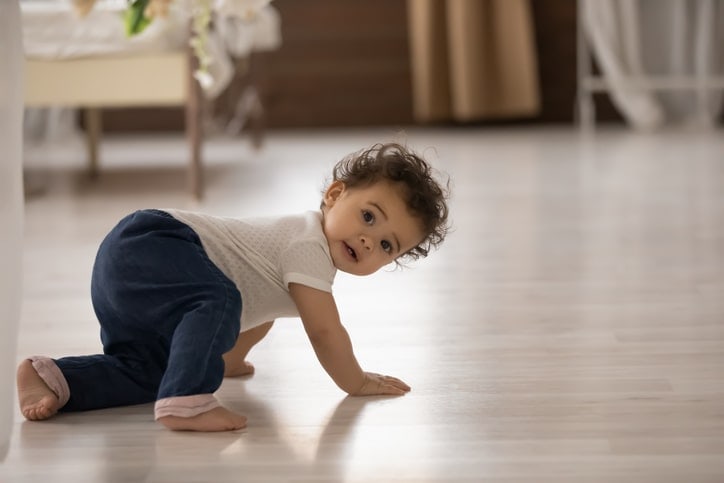
Babies aren’t developmentally “programmed” to crawl. Instead, babies are motivated to experiment with different ways of moving, and settle on whatever method seems the most rewarding. Thus, a baby might choose one of these styles of crawling:
- belly-crawling;
- hands-and-knees crawling; or
- hands-and-feet crawling;
or a baby might prefer to move using one of these alternative methods:
- bottom-shuffling (also known as “scooting”, or the “bottom scoot”);
- step-scooting (a kind of tripod shuffle, or “crab crawl”);
- cruising (walking while grasping handholds); or
- rolling;
all of which I describe in detail below. And it’s not unusual for babies to combine several techniques, or improvise their own, quirky modes of locomotion.
Why is there so much variety? You might think babies would all converge on the most efficient, best way to move from place to place. But that’s the crux of it: Babies may not agree about what’s best. For example, some infants may find crawling too uncomfortable, or prefer a form of locomotion that permits them to stay in an upright position.
It’s also clear that the environment plays a role. As we’ll see, babies are more likely to crawl when they have been given plenty of opportunities to move freely while lying on their stomachs. And the floor surface matters! For instance, researchers note that infants crawl at slower rates on hard surfaces – like wood flooring (Choi et al 2022).
So let’s take a closer look at the development of crawling and other modes of infant locomotion. When do babies crawl, why is there so much variation, and what can you expect to see during your baby’s first year? Here’s an evidence-based guide, with answers to frequently asked questions about crawling.
How do babies get started with crawling?
It begins with “tummy time,” those supervised sessions that your baby spends lying awake on his or her stomach. During tummy time, babies build up their neck muscles and shoulder muscles. They learn how to hold up their heads and shoulders, supporting themselves with their elbows. This strength and muscle control is essential for crawling, but babies don’t just stop there. As infants becomes stronger, they may try some of these moves:
- doing the “plank” (balancing on arms and feet, or on hands and knees)
- turning in circles (pivoting)
- rocking back and forth on hands and knees
- moving forward a step (either on belly, or on hands and knees)
- shifting back and forth between lying prone and sitting up
- trying to move forwards, but pushing backwards instead
Do babies have to master all of these skills before they begin to crawl?
No. But it’s likely your baby will practice at least one before taking the plunge (Adolf et al 1998).
Do babies have to sit up before they crawl?
Once again, the answer is no. Babies can begin belly-crawling before they have achieved this milestone. To learn more about the development of sitting upright, see this Parenting Science article.
Can you do anything to help your baby get started?
Yes! Get down on the floor with your baby, and make eye contact. Use smiles and talk to your baby to practice holding his or her head up. As your baby gets stronger, encourage your baby to approach you. And if your baby is struggling to learn the secret of forward propulsion — trying to move forward, but pushing backwards instead — try providing some resistance. Place your hands behind your baby’s feet, so your baby can push against them.
What’s next? For many babies, it’s belly-crawling. Other babies proceed directly to hands-and-knees crawling. And some babies adopt other, alternative approaches to locomotion.
Different styles of crawling
Belly-crawling: The commando crawl and the inchworm crawl
When we think of crawling, we often envision babies scampering around on hands and knees, their tummies held high above the ground. But some babies learn to crawl along on their bellies instead.
Is belly-crawling normal?
Yes, it’s entirely normal. In fact, when baby locomotion expert Karen Adolf and her colleagues studied the development of crawling in 28 American infants, they found that about half the infants started their crawling careers with some form of belly-crawling (Adolf et al 1998).
When do babies crawl on their bellies?
It varies from baby to baby. In the study by Adolf’s team, most belly-crawlers began sometime between the ages of 5 and 8.5 months.
What does belly-crawling look like?
There are two main styles or variants of belly-crawling:
Variant #1: The army crawl, aka “commando crawl.” This is easy to identify, and is illustrated in the photo here. A baby, lying prone (belly down), pulls himself forward with his arms, swiveling to the left and right as he moves.

Most of the propulsion comes from the upper body; the legs help a bit, fishtailing from side to side. But the baby is mostly dragging himself across the floor with his arms and shoulders. At any given point in an army crawl, the baby doesn’t have to worry about losing his balance. His weight is on his belly and thighs.
Variant #2: The “inchworm crawl.” In this variant of the belly-crawl, a baby pulls herself forward with both arms simultaneously, rising up slightly and then landing with a belly flop.

In the rising position, the baby is balanced briefly on her extremities, a bit like someone doing the plank.
Is your baby a commando crawler or an inchworm crawler? Commando crawling is more common, but it’s not unusual for a baby to do a bit of both. And whichever form of belly-crawling your baby favors, expect to see your baby graduate to hands-and-knees crawling (below). Belly-crawlers don’t remain belly-crawlers for long.
What if my baby doesn’t belly-crawl?
That’s nothing to worry about. Half the babies in Karen Adolf’s study skipped belly-crawling altogether, and, as we’ll see, it’s not unusual for babies to use other methods of locomotion. Why? If you’ve ever tried belly-crawling, you know that it’s very arduous! Depending on the surface and your speed, it can even be painful. Belly flops on the ground can smart. So many babies switch their focus on other motor skills instead.
The classic crawl: Moving on hands-and-knees

What about classic crawling? When do babies crawl on their hands and knees? Some researchers call this “creeping,” but I prefer the term “hands-and-knees crawling,” because it’s more descriptive of what babies do: Babies balance their weight on hands and knees, keeping their abdomens lifted off the ground.
If your baby has started belly-crawling, you can expect him or her to switch to hands-and-knees crawling within a couple of months. But belly-crawling isn’t a prerequisite. Some babies begin hands-and-knees crawling without any prior experience with belly-crawling.
Whatever your baby’s history, you’ll likely see signs before the fateful day. Babies tend to practice balancing first, rocking back and forth on their hands and knees. And those first steps?
According to an international study by the World Health Organization, babies usually begin hands-and-knees crawling sometime between 6 and 11 months, and approximately half of all babies begin crawling by 8.3 months (WHO 2006).
Alternatives to classic crawling: How else do babies move from place to place?
As noted above, babies discover or invent other methods of locomotion. Here are some of the most common alternatives.
The “bear crawl”

This type of crawling is similar hands-and-knees crawling. The baby’s abdomen is held high, but the baby keeps his or her knees off the ground, balancing instead on hands and feet.
The “step-crawl mix”
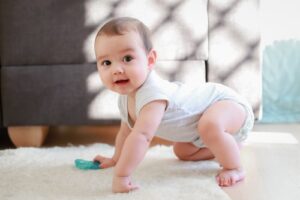
Another approach, sometimes called the “step-crawl mix,” looks like a bit like a mash-up of hands-and-knees crawling and bear-crawling. Babies crawl on the knee of one leg, while stepping with the foot of the other (Patrick et al 2012).
The “bottom scoot” (shuffling or scooting along the floor while sitting)
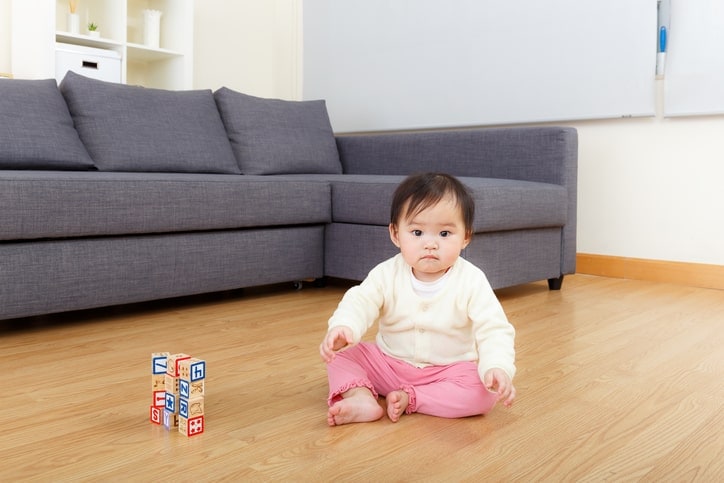
As seen in this YouTube video clip, some babies scoot along on their bottoms, sitting up and using their legs to power themselves across the floor. This style of movement has been called “scooting,” “hitching,” “bottom-shuffling,” and “the bottom scoot”. But whatever you call it, the key feature is that the baby’s bottom bears his or her weight, and the torso is an upright position.
The “crab crawl, also known as “step-scooting”

Babies also may move along tripod-style, in a mode that researchers have called “step-scooting” (Patrick et al 2012), and that other folks have called the “crab crawl.” It looks a little like bottom-shuffling, except that babies use one of their arms to help pull themselves along.
Cruising
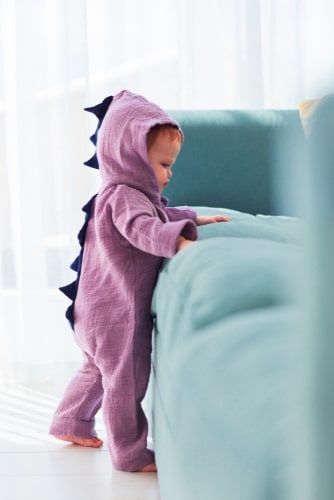
Some babies prefer to spend their time learning to “cruise” – to stand up and walk while holding the edges of furniture and other supports.
Rolling
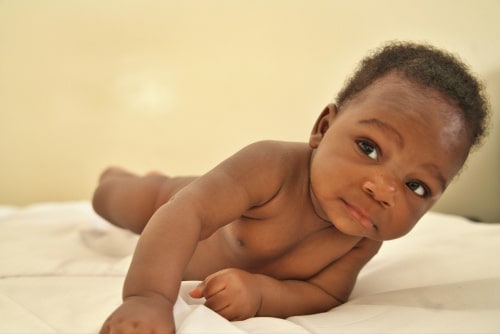
A few babies get from place to place by rolling on their sides.
So there isn’t any single, correct way to move. Different babies make different choices, and it’s normal for individual babies to use more than one mode of locomotion. Your baby might alternate between hands-and-knees crawling and bear walking. Or switch back and forth between scooting and some other form of movement (Adolf et al 1998; Patrick et al 2012).
Other questions about crawling
Why do some babies start crawling so much later than others?
1. Body type plays a role: Slimmer, lankier babies crawl sooner
It’s hard to drag your body around if you’re carrying a lot of extra weight! So leaner babies – who have a more favorable ratio of muscle to body fat – have an early advantage. As Karen Adolf’s team noticed in their longitudinal study of crawling, “Smaller, slimmer, more maturely proportioned infants tended to crawl at earlier ages than larger, chubbier infants” (Adolf et al 1998).
2. In addition, babies crawl earlier when they get lots of “tummy time.”
Research confirms that crawling is linked with the amount of waking time babies spend lying on their stomachs. Babies who get more “tummy time” and exercise tend to crawl at an earlier age (Kuo et al 2008; Lobo and Galloway 2012; Carson et al 2022).
3. Motivation matters too.
As noted, belly-crawling is grueling work, and hands-and-knees crawling requires a lot of balance control. Some babies may decide it’s not worth the trouble, and focus on learning other ways to move.
How soon after crawling do babies begin to walk?
As you might expect, it varies. For example, in a study of American babies, the average (median) time between the onset of crawling and the onset of walking was approximately 4 months. But the range was large. One baby remained in the crawling stage for 8.5 months. Another baby learned to crawl and walk on the same day (Adolf et al 2011)! For more information about walking, see my Parenting Science guide.
Do babies ever skip crawling and go straight to walking?
Yes, that does happen. Anthropologist David Tracer notes that there are entire cultures where this is common. Before learning to walk, babies in these cultures move around by bottom-shuffling. Tracer believes that bottom-shuffling — not crawling — was the mode of pre-walking locomotion most favored by our hunter-gatherer ancestors (Tracer 2009).
Nowadays, in contemporary Western countries, crawling is the norm. Nevertheless, a notable portion of babies in these societies reject crawling in favor of other methods. For instance, in a recent study tracking the development of 47,000 babies in Norway, researchers found that about 7% of children favored scooting or shuffling, not crawling. Yet these babies learned to walk, just as crawlers did (Storvold et al 2013).
Similarly, a researcher working in the 1980s found that about 9% of British babies preferred to bottom-shuffle. And 7% of babies transitioned to walking without having previously crawled or shuffled (Robson 1984).
Do parental practices affect the development of crawling?
Yes. In societies where parents discourage crawling — or provide infants with less “tummy time” — babies are less likely to crawl (Super 1976; Hopkins and Westra 1988; Hogbin 1943). On the flip side, researchers confirm that babies achieve motor milestones earlier – including the milestone of crawling – when their parents provide them with more than 30 minutes of tummy time each day. When parents in Canada followed this approached consistently (from 2 months through 6 months postpartum), their began crawling up to one month earlier (Carson et al 2022).
There’s also evidence that babies are influenced by cultural practices concerning clothing and the weather. For example, back in 1900, crawling was widespread in the United States, but less prevalent than it is today, with approximately 40% of babies using some alternative means of locomotion, like bottom-shuffling (Trettian 1900).
Why was crawling less common? Karen Adolf thinks it has to do with the long dressing gowns that babies used to wear. “When infants tried to crawl, their knees caught at the edge of their long gowns, pinning them in place”(Adolf 2008). So babies were more likely to reject crawling in favor of alternative solutions.
Nowadays, long dressing gowns aren’t typical, but researchers have noticed an interesting pattern around the world: In countries with marked seasons, babies tend to crawl earlier if they were born in the winter (Bai 2018). Why? Such infants reach the age of 6 months — prime time for learning to crawl — during the summer, when their parents dress them in less restrictive clothing, and permit them more opportunities to play on the ground. It seems, then, to come down to very practical considerations. Babies are more likely to crawl when parents make it easy for them to learn the necessary skills.
Why are some babies better at hands-and-knees crawling than others?
Once again, it comes down to practice. When Karen Adolf’s team analyzed hands-and-knees crawling, they found that the speediest, most proficient hands-and-knees crawlers tended to have certain things in common.
Before the onset of hands-and-knees crawling, these babies had racked up more experience with “tummy time” skills, including swimming in place, pivoting around in circles on their stomachs, and rocking back and forth on hands and knees. In addition, babies who had a history of belly-crawling had an advantage: From the very first days that they adopted hands-and-knees crawling, they were faster and more efficient (Adolf et al 1998).
So all that hard work pays off. If you train like a marine, you will have a head start with hands-and-knees crawling.
If a baby doesn’t crawl, will he or she be any slower to achieve the milestone of walking?
Maybe, but research suggests in won’t make much difference in the long-run. And in some cases, babies who skip crawling actually end up walking sooner. For instance, in the Norwegian study, the scooting, shuffling babies took an average of 3.5 weeks longer to take their first, independent steps (Storvold et al 2013). Likewise, the British study found that bottom-shufflers walked at a slightly later age (Robson 1984).
Yet the earliest walkers in the British study were the ones who began walking without having been observed to engage in any prior form of locomotion, a finding replicated by a small study of Turkish children (Cimbiz and Bayazit 2005).
When should I worry?
Some children experience impairments in motor development, and, for these kids, delays in crawling can be one of the early signs of a problem. In a recent study of 3- to 6-year-olds children in China, parents who remembered their kids as having started crawling later — even a month or two later than average — were more likely to report other, subsequent motor delays (Hua et al 2022).
But, as we’ve seen, it’s normal for some babies to reject crawling in favor of other modes of locomotion, and the age range for the onset of crawling is very wide. Crawling isn’t a universal motor milestone, and in fact both the Center for Disease Control and the American Academy of Pediatrics have removed crawling from their milestone “checklists” (Zubler et al 2022). So you shouldn’t worry merely because your baby isn’t crawling. As long as your baby shows progress over time — developing ways of moving from place to place, and hitting other motor milestone targets — you should feel reassured that your baby’s skills are on track.
When, then, should you be concerned? If your baby isn’t making progress with any sort of locomotion by the age of 12 months — or shows evidence of weakness or poor control on one side of the body — talk with your pediatrician.
And remember: You should always consult your pediatrician if something doesn’t feel right. If there is a problem, early intervention can help get your baby back on track.
Wondering when your baby will begin walking? And what stages of development to watch for?
Be sure to check out my article, “When do babies start walking?” This article explains:
- signs that your baby will begin walking soon
- stages of learning to walk
- the timing of (1) learning to walk with support; and (2) learning to walk independently
- cultural and parenting factors that can speed up (or slow down the process)
More evidence-based information about developmental milestones
To learn more about how babies learn to move and manipulate objects, see my article, “Motor milestones: How do babies develop during the first two years?” In addition, check out my articles about other developmental topics, including
- When do babies sit up by themselves, and what can we do to help them reach this milestone?
- When do babies speak their first words?
- How to support language development in babies
- Do babies feel empathy?
- How to start babies on solid food
- Baby sleep tips: A guide for the science-minded parent
References: When do babies crawl?
Adolph KE, Berger SE, Leo AJ. 2011. Developmental continuity? Crawling, cruising, and walking. Dev Sci. 14(2):306-18
Adolph KE, Cole WG, Komati M, Garciaguirre JS, Badaly D, Lingeman JM, Chan GL, Sotsky RB. 2012. How do you learn to walk? Thousands of steps and dozens of falls per day. Psychol Sci. 23(11):1387-94
Adolph KE, Vereijken B, Denny MA. 1998. Learning to crawl. Child Dev. 1998 Oct;69(5):1299-312.
Bai Y, Shang G, Wang L, Sun Y, Osborn A, Rozelle S. 2018. The relationship between birth season and early childhood development: Evidence from northwest rural China. PLoS One. 13(10):e0205281.
Bottos M, Dalla Barba B, Stefani D, Pettenà G, Tonin C, D’Este A. 1989. Locomotor strategies preceding independent walking: prospective study of neurological and language development in 424 cases. Dev Med Child Neurol. 31(1):25-34.
Carson V, Zhang Z, Predy M, Pritcher L and Hesketh KD. 2022. Adherence to Canadian 24-Hour Movement Guidelines among infants and associations with development: a longitudinal study. Int J Behav Nutr Phys Act 19: 154.
Choi J, Ogawa T, Takesue S, Muraki S, Inoue Y, Abe H, Yamanoi E. 2022. Different flooring surfaces affect infants’ crawling performance. Appl Ergon. 98:103553.
Cimbiz A and Bayazit V. 2005. Effects of infant crawling experience on range of motion. Neurosciences 10 (1): 34-40.
Hogbin HI. 1943. A New Guinea infancy: From conception to weaning in Wogeo. Oceania 13: 285-309.
Hopkins B and Westra T. 1988. Maternal handling and motor development: an intracultural study. Genet Soc Gen Psychol Monogr. 114(3):377-408.
Hua J, Williams GJ, Jin H, Chen J, Xu M, Zhou Y, Gu G, Du W. 2022. Early Motor Milestones in Infancy and Later Motor Impairments: A Population-Based Data Linkage Study. Front Psychiatry. 13:809181.
Karasik LB, Tamis-LeMonda CS, Adolph KE. 2011. Transition from crawling to walking and infants’ actions with objects and people. Child Dev. 82(4):1199-209.
Kretch KS, Franchak JM, Adolph KE. 2014. Crawling and walking infants see the world differently. Child Dev. 85(4):1503-18.
Kuo YL, Liao HF, Chen PC, Hsieh WS, Hwang AW. 2008. The influence of wakeful prone positioning on motor development during the early life. J Dev Behav Pediatr. 29(5):367-76.
Lobo MA and Galloway JC. 2012. Enhanced handling and positioning in early infancy advances development throughout the first year. Child Dev. 83(4):1290-302
Patrick SK, Noah JA, Yang JF. 2012. Developmental constraints of quadrupedal coordination across crawling styles in human infants. J Neurophysiol. 107(11):3050-61.
Robson P. 1984. Prewalking locomotor movements and their use in predicting standing and walking. Child Care Health Dev. 198410(5):317-30.
Størvold GV, Aarethun K, Bratberg GH. 2013. Age for onset of walking and prewalking strategies. Hum Dev. 89(9):655-9.
Super CM. 1976. Environmental effects on motor development: the case of “African infant precocity”. Dev Med Child Neurol. 18(5):561-7.
Tracer DP. 2009. Infant carrying and prewalking locomotor development: proximate and evolutionary perspectives. Proceedings of the 78th Annual Meeting of the American-Association-of-Physical-Anthropologists; Chicago, IL.
Trettien AW. 1900. Creeping and walking. The American Journal of Psychology. 12:1–57.
WHO Multicentre Growth Reference Study Group. 2006. WHO Motor Development Study: windows of achievement for six gross motor development milestones. Acta Paediatr Suppl. 450:86-95.
Zubler JM, Wiggins LD, Macias MM, Whitaker TM, Shaw JS, Squires JK, Pajek JA, Wolf RB, Slaughter KS, Broughton AS, Gerndt KL, Mlodoch BJ, Lipkin PH. 2022. Evidence-Informed Milestones for Developmental Surveillance Tools. Pediatrics. 149(3):e2021052138.
Content of “When do babies crawl?” last modified 12/22/22. Portions of text based on previous versions of this article, written by the same author.
Image and video credits for “When do babies crawl?”
title image of baby looking over shoulder while trying to crawl by fizkes / istock
image of baby commando crawling by Yaoinlove / istock
image of baby inchworm crawling by MangoStar_Studio / istock
image of baby with flowers in hair crawling on hands and knees by JBrownInTheLight / istock
image of baby “bear crawling” by shevtsovy / shutterstock
image of baby step-crawl mix by Onjira Leibe / shutterstock
image of bottom-scooting infant by leungchopan / istock
Link: youtube video clip of baby bottom-shuffling by Mal Chia
image of baby next to couch step-scooting by RONNACHAIPARK / shutterstock
image of baby cruising (and wearing dinosaur costume) by Olesia Bilkei / shutterstock
image of baby in the midst of rolling over by Gwill / shutterstock